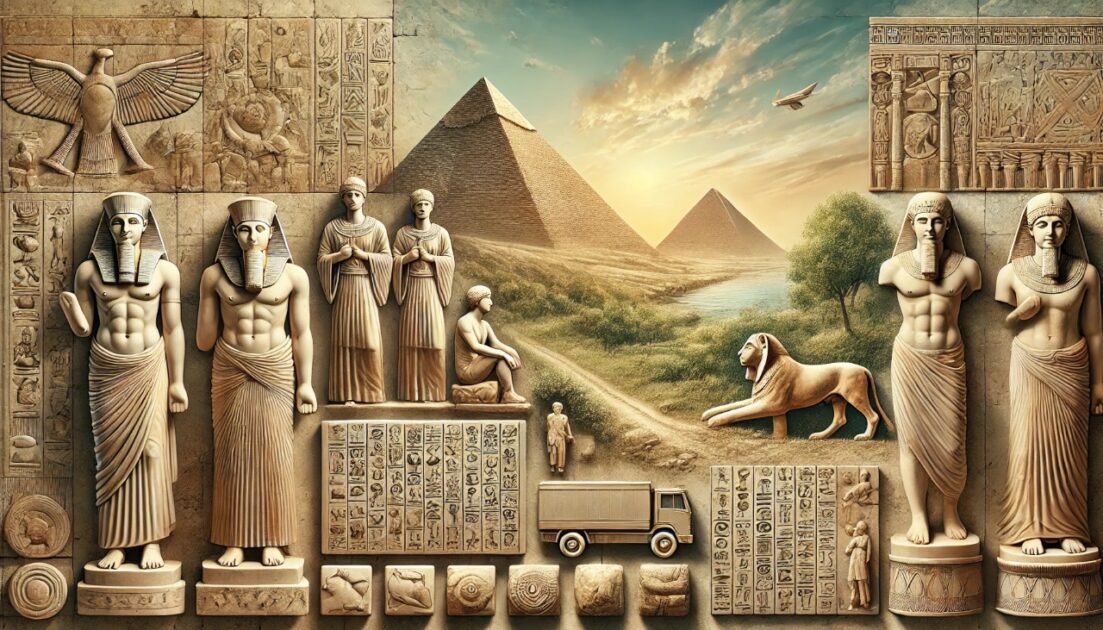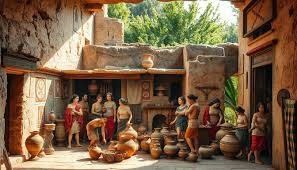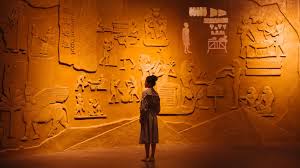
Ancient Arts the term “ancient arts” refers to the diverse and rich artistic expressions from civilizations around the globe that date back thousands of years. These art forms encompass a wide array of mediums, including visual arts, sculpture, pottery, textiles, and performance arts. Each ancient culture contributed unique techniques and styles that reflect their beliefs, values, and daily lives. This article delves deeper into the intricate tapestry of ancient arts, exploring specific examples, techniques, and their cultural significance across various civilizations.

1. Visual Arts
Visual arts are one of the most prominent aspects of ancient cultures, serving both decorative and functional purposes. They often reflected the values and beliefs of the societies that created them.

Egyptian Art
Functionality and Symbolism: Ancient Egyptian art was deeply entwined with religion and the afterlife. The most famous works include wall paintings found in tombs, which depicted scenes of everyday life, agricultural activities, hunting, and rituals. These artworks were intended to provide for the deceased in the afterlife, showcasing a belief in immortality.
Artistic Conventions: Egyptian artists adhered to strict conventions. Figures were often depicted in a composite view: heads and legs were shown in profile, while torsos were presented frontally. This style aimed for clarity and representation rather than realism. The use of color was also symbolic; for example, green symbolized fertility and rebirth, while red was associated with chaos and disorder.
Notable Works: One of the most iconic pieces of Egyptian art is the “Book of the Dead,” a funerary text filled with illustrations and spells meant to guide the deceased through the afterlife. Additionally, the magnificent tomb paintings in the Valley of the Kings illustrate the grandeur of pharaonic art.
Greek Art
Evolution Through Eras: Greek art evolved through several distinct periods, each characterized by different styles and techniques. The Archaic period featured rigid, stylized figures in sculptures, while the Classical period embraced naturalism, proportion, and idealized beauty. The Hellenistic period introduced greater emotional expression and dynamic movement in both sculpture and painting.

Sculpture: Greek sculptors, such as Phidias, created lifelike marble statues that celebrated human form and beauty. The Parthenon, dedicated to Athena, is adorned with exquisite friezes and sculptures that narrate mythological tales and civic pride.
Pottery: Greek pottery also underwent significant transformation. The black-figure technique, where figures were painted in a black slip against the natural clay, allowed for intricate designs. This was later replaced by the red-figure technique, which permitted more detailed depictions of human anatomy and scenes from mythology.
Mesopotamian Art
Cultural Syncretism: Mesopotamian art reflects the diverse cultures within the region, including the Sumerians, Akkadians, Babylonians, and Assyrians. Artworks served both functional and decorative purposes, often reflecting the political and religious dynamics of the time.
Architectural Innovations: The ziggurat, a massive terraced structure, served religious functions and demonstrated advancements in architecture. The Ziggurat of Ur, dedicated to the moon god Nanna, showcases the significance of religion in Mesopotamian society.
Reliefs and Seals: Cylinder seals were a notable art form, often used to mark ownership or signify authority. These small, intricately carved stone objects depicted scenes of mythology, daily life, and religious rituals, showcasing the artisans’ skills.
2. Sculpture
Sculpture in ancient cultures varied in style and purpose, often emphasizing religious, political, or commemorative themes.
Roman Sculpture
Adoption of Greek Styles: Roman sculpture borrowed heavily from Greek traditions, yet it also innovated. While Greek art emphasized idealized beauty, Roman sculptors focused on realism, creating detailed portraits that captured the subject’s character and age.
Monumental Statues: The Colosseum, a marvel of engineering and architecture, is adorned with numerous sculptures that narrate the triumphs and battles of emperors and gods. The statue of Marcus Aurelius, which survives from antiquity, exemplifies the Roman approach to portraiture.
Funerary Art: The Romans also developed elaborate funerary art, with sarcophagi adorned with reliefs depicting mythological scenes or the deceased’s life. These artworks served as both memorials and reflections of the individual’s status.
Indian Art
Spiritual and Cultural Significance: Ancient Indian sculptures often held deep spiritual significance, reflecting the rich tapestry of Hinduism and Buddhism. The Maurya and Gupta periods saw the creation of intricate sculptures that depicted deities, spiritual narratives, and historical figures.
Rock-Cut Caves: The Ajanta and Ellora caves in India are famous for their stunning rock-cut sculptures and murals. These caves showcase scenes from Buddhist Jataka tales, reflecting the moral and ethical teachings of Buddhism.
Temple Architecture: Indian temples are adorned with intricate carvings and sculptures that narrate mythological stories, embodying the relationship between art and spirituality. The intricate sculptures of Khajuraho depict a blend of religious themes and everyday life.
3. Pottery and Ceramics
Pottery served as both functional and artistic expression in many ancient cultures, reflecting technological advancements and cultural practices.
Chinese Pottery
Historical Development: Chinese pottery has a rich history, with the earliest examples dating back to the Neolithic period. Techniques evolved significantly over time, culminating in the production of fine porcelain during the Tang and Song dynasties.
Tang Dynasty Ceramics: Tang pottery is known for its vibrant colors and intricate designs. The famous “Sancai” or “three-color” glazed wares were often used in burial goods, showcasing the importance of art in funerary practices.
Song Dynasty Porcelain: The Song dynasty marked the pinnacle of Chinese porcelain craftsmanship. The iconic blue-and-white porcelain, with its delicate designs and vibrant glazes, became highly sought after and influenced global ceramics.
Mesoamerican Pottery
Cultural Expression: Mesoamerican pottery from civilizations like the Maya and Aztecs was often adorned with intricate designs and motifs that conveyed social status, religious beliefs, and daily life. Pottery played a crucial role in both domestic and ceremonial contexts.
Maya Pottery: Maya ceramics were characterized by elaborate designs, often depicting gods, animals, and scenes from mythology. The use of slip decoration and polychrome painting demonstrated the artisans’ skills and the importance of pottery in Maya culture.
Aztec Pottery: Aztec pottery featured utilitarian wares alongside intricate ceremonial pieces. The use of geometric patterns and vibrant colors reflected the rich cultural heritage of the Aztecs, with many pieces serving ritualistic purposes.
4. Textiles
Textiles are a crucial aspect of ancient arts, providing insight into the technological advancements, trade, and cultural identity of societies.
Andean Textiles
Complex Techniques: The ancient Andean cultures, such as the Incas and the Paracas, produced highly sophisticated textiles known for their intricate patterns and vibrant colors. The use of alpaca and llama wool allowed for warm, durable textiles that were often dyed using natural pigments.
Symbolism in Weaving: Textiles held significant cultural and social meaning in Andean societies. Patterns and colors often conveyed status, identity, and community ties. The famous “Inca tunics” were not only functional but also a reflection of the wearer’s position within society.
Cultural Continuity: Even after the fall of the Inca Empire, traditional weaving techniques have been preserved among indigenous communities in the Andes, showcasing the enduring legacy of ancient textile arts.
Middle Eastern Textiles
Innovations and Trade: Ancient Middle Eastern cultures, from the Mesopotamians to the Persians, developed advanced textile production techniques. Wool and linen were the primary materials used, with intricate patterns often inspired by nature and geometry.
Carpets and Tapestries: The production of carpets and tapestries became highly sophisticated, especially during the Islamic Golden Age. These textiles were often adorned with elaborate floral patterns, calligraphy, and geometric designs, reflecting both artistic skill and cultural identity.
Cultural Exchange: The Silk Road facilitated the exchange of textiles, leading to the incorporation of diverse styles and techniques across cultures. The blending of motifs and designs illustrates the interconnectedness of ancient societies.
5. Performance Arts
Performance arts, though less tangible than other forms of art, have played a crucial role in ancient cultures, often serving religious, social, and political functions.
Theater in Ancient Greece
Origins and Development: Greek theater originated as part of religious festivals honoring Dionysus, the god of wine and fertility. The earliest forms of drama included dithyrambs—choric songs—and evolved into tragedies and comedies, with playwrights like Aeschylus, Sophocles, and Aristophanes at the forefront.
Themes and Innovations: Greek tragedies explored complex themes of fate, morality, and human nature, often invoking the gods’ will. Comedies, on the other hand, provided social commentary, addressing contemporary issues with humor and satire. The use of masks and elaborate costumes was a hallmark of Greek theater, allowing actors to portray multiple roles.
Cultural Impact: The influence of Greek theater extended beyond its time, laying the groundwork for Western drama and performance arts. The enduring themes and character archetypes continue to resonate in modern literature and theater.
Dance and Ritual
Cultural Significance: Dance has been a vital form of expression in many ancient cultures, often linked to religious ceremonies, storytelling, and community celebrations. It served as a means of connecting with the divine and expressing cultural identity.
Ritualistic Practices: In ancient Egypt, dance was an integral part of religious ceremonies, often performed to honor the gods or commemorate significant events. Similarly, Native American tribes incorporated dance into rituals, storytelling, and communal gatherings, using it as a means of preserving culture and identity.
Evolution of Styles: As cultures interacted and evolved, so too did their dance forms. The blending of styles and traditions has given rise to diverse dance practices observed in various cultures today, showcasing the continuity and adaptation of ancient performance arts.
6. Legacy and Influence of Ancient Arts
The ancient arts continue to resonate in contemporary culture, influencing modern artists, architects, and performers. The techniques, themes, and philosophies derived from ancient civilizations have laid the groundwork for various art movements throughout history.
Revival and Inspiration
Renaissance Influence: During the Renaissance, European artists drew inspiration from classical antiquity, reviving the ideals of beauty, proportion, and naturalism exemplified in ancient Greek and Roman art. This revival led to groundbreaking developments in painting, sculpture, and architecture.
Modern Interpretations: Contemporary artists often reference ancient art in their work, exploring themes of identity, heritage, and cultural continuity. The use of ancient techniques, materials, and motifs can be seen in various forms of modern art and design.
Preservation Efforts: Today, efforts to preserve ancient art and artifacts are crucial for understanding human history. Museums, archaeological sites, and cultural institutions work to protect and promote the legacy of ancient arts, ensuring that future generations can appreciate their significance.
7. Conclusion
The ancient arts provide invaluable insight into the cultures and societies that produced them, reflecting their values, beliefs, and experiences. From the vivid murals of Egypt to the intricate textiles of the Andes, these artistic expressions connect us to our shared human history. As we study and appreciate these art forms, we gain a deeper understanding of the creativity and innovation that have shaped civilizations throughout time. The legacy of ancient arts continues to inspire and influence contemporary artists and cultures around the world, reminding us of the enduring power of human expression and creativity.For more detail please visit techwebinsights.com
4o mini







